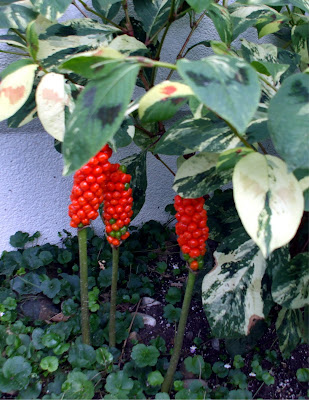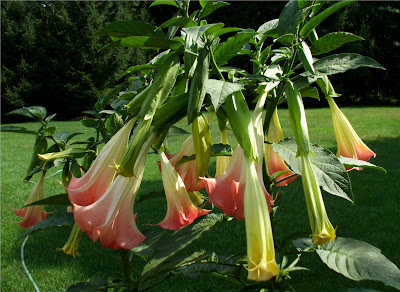If the heat has kept you out of the garden lately, you might be staring at a lot of dead heads. Yesterday I was confronted with a huge patch of brown-headed shasta daisies. I snipped about half of them and then gave up, not sure whether my clients even cared. Pulling out the dead stalks on the daylilies is also tedious, but they look so much better and some seem to respond with new foliage. It distresses me to see all the brown stalks around town.
How would you like to deadhead this patch of hostas and daylilies? (It is over 3 times the size shown):
Noticing all the crisping August lawns littered with maple leaves already dropping, I am thrilled with the prospect of some fall weather. The dog days are finally over. I actually opened the deck doors this morning for a little fresh air that did not compete with the air conditioning. AHHH.
Fall is probably my favorite season of the year. I love the freshness and abundant blooms of spring and even the rain, but the dryer cool air of fall is where it's at for me. The color of the trees in Michigan is just a bonus. Spring is for my heart. Fall is for my soul.
But the beginning of fall is over a month away and that old song from the 60's comes to mind, the first three verses written in 1955 by Pete Seeger and hitting the pop charts in 1961 as recorded by the Kingston Trio:
Where have all the flowers gone?
Long time passing.
It is a simple, repetitive song and I'm not sure what it means, but it was a strummin' good campfire song for years.
I grabbed my camera at Aunt V's house today, determined to find something interesting to photograph. In the back I found that the toad lily had opened--such a bad name for this dainty beauty:
 |
| Tricyrtis 'Taipei Silk' |
In the front I found the Japanese Anemone just about to open:
By the waterfall pond the Ligularia was blooming:
The white hostas (above) were still in bloom; around the bend I saw that the Rainbow Knock Out Roses planted last year had some new blooms after being ravaged by Japanese Beetles earlier:
 |
| Rosa 'Radcor' |
Near the back of the berm I found these flowers:


On the back of the berm I spied Joe-Pye Weed and some pink turtlehead:
 |
| Eupatorium |
 |
| Chelone Lyonii ('hot lips'?) |
I had to search hard, but was gratified that I could find a spot or two of color in the landscape today.
 My nostalgia for all things fall was heightened by the sight of the beautiful fruit clusters--soon it will be the season of apple picking, pumpkins, apple cider donuts and maybe a horseback ride or color tour through brilliant autumn foliage. I was already in the mood, having just browsed my first issue of Midwest Living (so inexpensive that I could not resist one more magazine subscription). It featured short stories of favorite fall excursions, written by gals, traveling with their pals, accompanied by professionals taking photos. Included was a reference to returning home to make Dutch Apple Pie from an old cookbook that is in almost every Dutch home in West Michigan.
My nostalgia for all things fall was heightened by the sight of the beautiful fruit clusters--soon it will be the season of apple picking, pumpkins, apple cider donuts and maybe a horseback ride or color tour through brilliant autumn foliage. I was already in the mood, having just browsed my first issue of Midwest Living (so inexpensive that I could not resist one more magazine subscription). It featured short stories of favorite fall excursions, written by gals, traveling with their pals, accompanied by professionals taking photos. Included was a reference to returning home to make Dutch Apple Pie from an old cookbook that is in almost every Dutch home in West Michigan.










